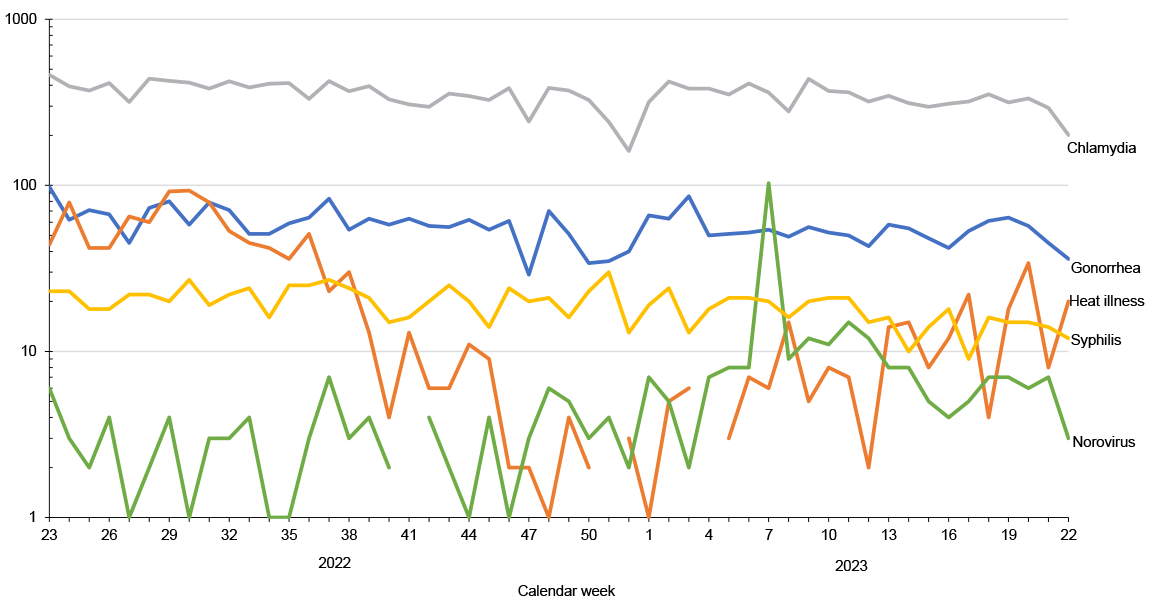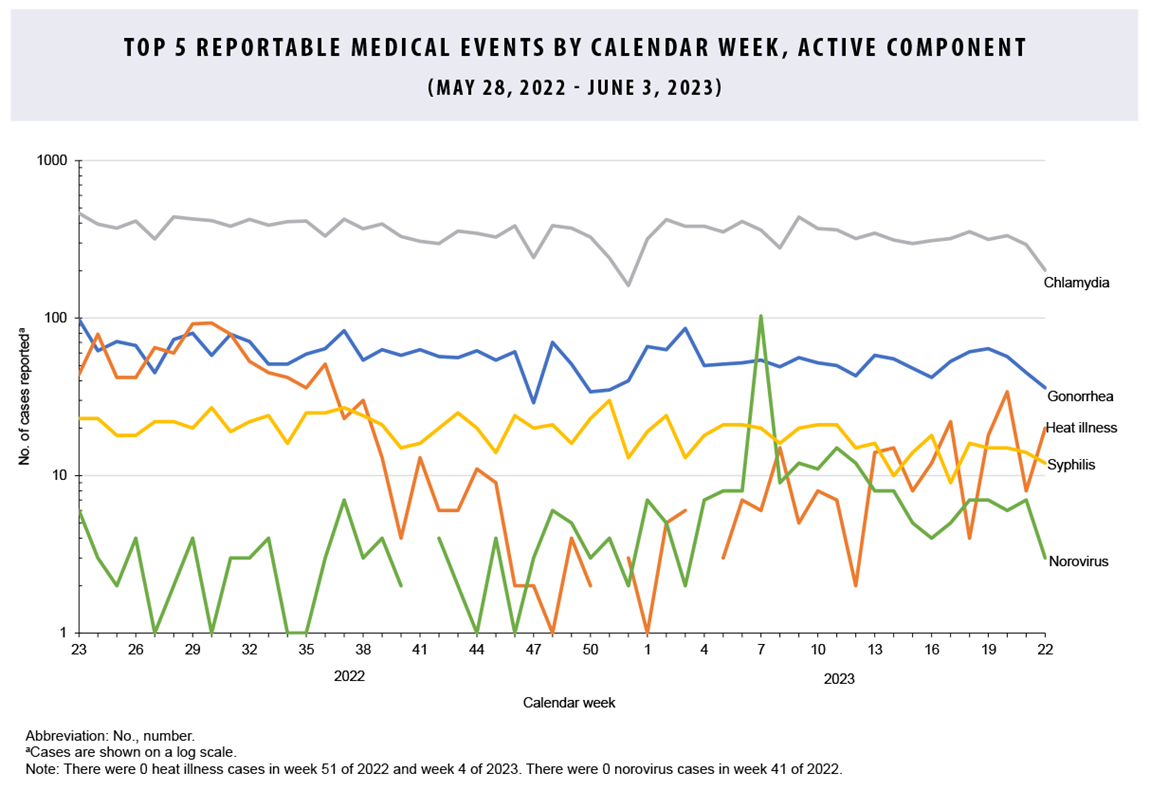Reportable Medical Events, Military Health System Facilities, Week 22, Ending June 3, 2023
 Graph depicting the frequency of the five most common reportable medical events within the Military Health System over the preceding year.
Graph depicting the frequency of the five most common reportable medical events within the Military Health System over the preceding year.
Reportable Medical Events are documented in the Disease Reporting System internet by health care providers and public health officials across the Military Health System for the purpose of monitoring, controlling, and preventing the occurrence and spread of diseases of public health interest or readiness importance. These reports are reviewed by each service’s public health surveillance hub. The DRSi collects reports on over 70 different RMEs, including infectious and non-infectious conditions, outbreak reports, STI risk surveys, and tuberculosis contact investigation reports. A complete list of RMEs is available in the 2022 Armed Forces Reportable Medical Events Guidelines and Case Definitions.1 Data reported in these tables are considered provisional and do not represent conclusive evidence until case reports are fully validated.

Total active component cases reported per week are displayed for the top five RMEs for the previous year. Each month, the graph is updated with the top five RMEs, and is presented with the current month’s (May 2023) top five RMEs, which may differ from previous months. COVID-19 is excluded from these graphs due to changes in reporting/case definition updates in 2023.

References
- Armed Forces Health Surveillance Division. Armed Forces Reportable Medical Events. Accessed April 6, 2023. https://www.health.mil/Military-Health-Topics/Health-Readiness/AFHSD/Reports-and-Publications/Armed-Forces-Reportable-Medical-Events
- Defense Manpower Data Center. Department of Defense Active Duty Military Personnel by Rank/Grade of Service, October 31, 2022. https://dwp.dmdc.osd.mil/dwp/app/dod-data-reports/workforce-reports
- Defense Manpower Data Center. Armed Forces Strength Figures for January 31, 2023. https://dwp.dmdc.osd.mil/dwp/app/dod-data-reports/workforce-reports
- Navy Medicine. Surveillance and Reporting Tools–DRSI: Disease Reporting System Internet. https://www.med.navy.mil/Navy-Marine-Corps-Public-Health-Center/Preventive-Medicine/Program-and-Policy-Support/Disease-Surveillance/DRSI
You also may be interested in...
Policy
Aug 28, 2007
 .PDF |
64.01 KB
.PDF |
64.01 KB
Updated Changes to Health Affairs' Policy on Dental Readiness within the Services
- Identification #: 07-017
- Type: Memorandum
Report
Jun 1, 2007
 .PDF |
591.42 KB
.PDF |
591.42 KB
Defense Health Board: Report of the Department of Defense Task Force on Mental Heath
Presentation
May 3, 2007
 .PDF |
1.40 MB
.PDF |
1.40 MB
Vaccine Health Centers briefing for the Defense Health Board May 3, 2007
Presentation
May 3, 2007
 .PDF |
1.69 MB
.PDF |
1.69 MB
DoD Pandemic Influenza Preparedness briefing for the Defense Health Board May 3, 2007
Presentation
May 3, 2007
 .PDF |
2.20 MB
.PDF |
2.20 MB
Military Vaccine Program briefing for the Defense Health Board May 3, 2007
Policy
Apr 23, 2007
This Directive establishes policy and assigns responsibility for implementing Force Health Protection (FHP) measures, on behalf of all Military Service members during active and Reserve military service, encompassing the full spectrum of missions, responsibilities, and actions of the DoD Components in establishing, sustaining, restoring, and improving ...
- Identification #: DoD Directive 6200.04
- Type: Directive
Report
Jan 1, 2007
 .PDF |
1.28 MB
.PDF |
1.28 MB
A monthly publication of the Armed Forces Health Surveillance Branch. This issue of the peer-reviewed journal contains the following articles: Leishmaniasis in relation to service in Iraq/Afghanistan, U.S. Armed Forces, 2001 – 2006; Hospitalizations among members of active components, U.S. Armed Forces, 2006; Ambulatory visits among members of active ...
Report
Jan 1, 2007
 .PDF |
311.88 KB
.PDF |
311.88 KB
A monthly publication of the Armed Forces Health Surveillance Branch. This issue of the peer-reviewed journal contains the following articles: Relationships between abnormal findings during medical examinations and subsequent diagnoses of significant conditions, active components, U.S. Armed Forces, January 1998-October 2006; ARD surveillance update; ...
Report
Jan 1, 2007
 .PDF |
504.24 KB
.PDF |
504.24 KB
A monthly publication of the Armed Forces Health Surveillance Branch. This issue of the peer-reviewed journal contains the following articles: Hospitalization Experience within One Year after Returning from Afghanistan or Iraq, January 2002-September 2006; Outbreak of Acute Gastroenteritis Due to Norovirus, Fort Dix, New Jersey, December 2006; Heat ...
Report
Jan 1, 2007
 .PDF |
2.89 MB
.PDF |
2.89 MB
A monthly publication of the Armed Forces Health Surveillance Branch. This issue of the peer-reviewed journal contains the following articles: "Indicator" infectious illnesses, staphylococcal infections, and penicillin resistance among active component members, U.S. Armed Forces, January 2002-June 2007; Mental health-related clinical experiences in ...
Report
Jan 1, 2007
 .PDF |
851.77 KB
.PDF |
851.77 KB
A monthly publication of the Armed Forces Health Surveillance Branch. This issue of the peer-reviewed journal contains the following articles: The MSMR: The First 100 Issues and the Future; Relationships between the Timing and Causes of Hospitalizations Before and After Deploying to Iraq or Afghanistan, Active Components, U.S. Armed Forces, 2002-2005 ...
Report
Jan 1, 2007
 .PDF |
649.71 KB
.PDF |
649.71 KB
A monthly publication of the Armed Forces Health Surveillance Branch. This issue of the peer-reviewed journal contains the following articles: Routine screening and referrals for Post-Traumatic Stress Disorder (PTSD) after returning from Operation Iraqi Freedom in 2005, U.S. Armed Forces; Relationship between influenza vaccination and subsequent ...
Report
Jan 1, 2007
 .PDF |
635.60 KB
.PDF |
635.60 KB
A monthly publication of the Armed Forces Health Surveillance Branch. This issue of the peer-reviewed journal contains the following articles: Traumatic brain injury among members of active components, U.S. Armed Forces, 1997-2006; Heterotopic ossification, active components, U.S. Armed Forces, 2002-2007; Routine screening for antibodies to HIV-1, U.S ...
Report
Jan 1, 2007
 .PDF |
2.86 MB
.PDF |
2.86 MB
A monthly publication of the Armed Forces Health Surveillance Branch. This issue of the peer-reviewed journal contains the following articles: Korea-acquired malaria, U.S. Armed Forces, January 1998-October 2007; Diagnoses of "envenomations" in relation to diagnoses of skin and soft tissue infections due to staphylococci/penicillin resistant bacteria, ...
Report
Jan 1, 2007
 .PDF |
583.03 KB
.PDF |
583.03 KB
A monthly publication of the Armed Forces Health Surveillance Branch. This issue of the peer-reviewed journal contains the following articles: Mental health encounters and diagnoses following deployment to Iraq and/or Afghanistan, U.S. Armed Forces, 2001-2006; Hormonal contraceptive use among female service members, active components, U.S. Armed ...
You are leaving Health.mil
The appearance of hyperlinks does not constitute endorsement by the Department of Defense of non-U.S. Government sites or the information, products, or services contained therein. Although the Defense Health Agency may or may not use these sites as additional distribution channels for Department of Defense information, it does not exercise editorial control over all of the information that you may find at these locations. Such links are provided consistent with the stated purpose of this website.
You are leaving Health.mil
View the external links disclaimer.
Last Updated: August 24, 2023